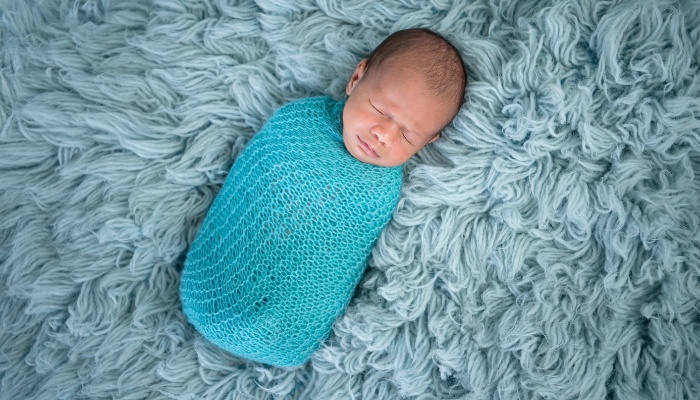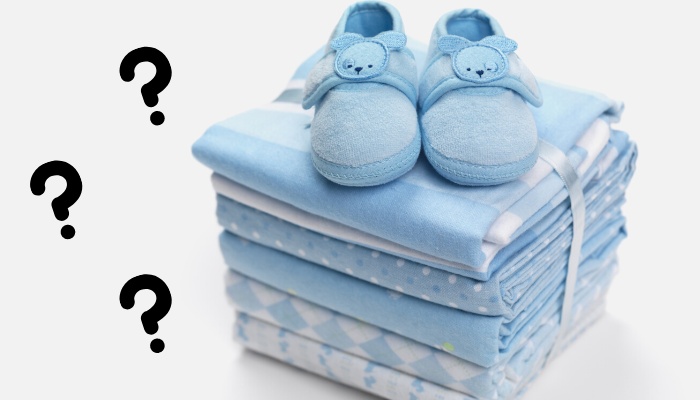The vast selection of swaddling blankets and wraps available can be overwhelming, particularly for a new parent who only wants to purchase necessary items.
Babies don’t need to be swaddled for very long, but they can go through a surprising amount in a short space of time! So first things first…
How many swaddling blankets do I need? It’s a good idea to start with two to three simple swaddling blankets for newborns, though more may be necessary if they frequently spit up or have diaper leaks. As your baby grows, they can move on to a swaddle sack, allowing for arms-out sleeping as they transition from swaddling.
Every baby’s needs are different, so if you end up with an excessive amount of swaddling blankets, don’t worry that you’ve wasted money as these blankets are super versatile and can come in handy as nursing covers, stroller blankets, and more.
To get an idea of how many you might need, let’s look into some buying considerations, which swaddle types to avoid, and more.
How Many Swaddling Blankets – 7 Factors To Consider
The short answer? Two swaddling blankets are the minimum number so you have a spare ready to go.
However, the number you may actually need depends on a few factors, like how your little one takes to them and your typical laundry cycle.
1. Your Baby May Not Like To Be Swaddled
This early sleep phase can be unpredictable, and you are still learning your baby’s preferred way of sleeping.
Some babies love to sleep with their arms straight by their side, for example, while others prefer to have their hands free, and certain types of swaddling blankets can restrict this.
Muslin swaddle designers Aden + Anais advise thinking about how loose or tight the swaddle is and the timing of the swaddling: “an overtired baby may react differently than a baby that is in the process of winding down.”
2. Hospitals Usually Provide Swaddle Blankets
Before you order a bulk load of swaddles, it’s worth noting that most hospitals typically provide blankets when your baby is first born, and some often provide wearable swaddle wraps as a parting gift to make things easier for new parents.
3. How Often Do You Do Laundry?
Depending on the frequency of your little one’s spit-ups, diaper leaks, and code-brown situations, you could go through between three and six swaddles a day, so weigh up how many you’ll need based on your typical laundry schedule.
4. Your Baby Won’t Be Swaddled All the Time
“Since your baby should only use swaddles for sleep, they aren’t likely to get dirty,” notes Pediatric Sleep Consultant and founder of The Postpartum Party Amy Motroni and “three to five swaddles that you can rotate between is perfect.”
5. Not All Swaddles Are the Same Size
Some swaddle blankets are available from newborn size up to wearable “onesie” style swaddles for toddlers, but swaddling is only intended for babies up to 2-3 months when they begin to roll.
Only look for swaddling blankets and products in sizes labeled “Newborn” and “0-3 Months.”
6. Swaddle Material
It’s important that the swaddling material is soft, lightweight, breathable, and stretchy.
Certain swaddling blankets may not retain their soft, baby-friendly qualities after repeated washes, so it could be worth investing in two to three high-quality swaddles rather than five to eight mid-range ones.
7. You Won’t Be Swaddling Your Baby for Long
The swaddling period is such a narrow window of time, so it won’t make sense to stock up on tons of blankets.
To reduce the risk of SIDS (Sudden Infant Death Syndrome), swaddling should stop as soon as your baby shows the first signs of trying to roll over, which usually happens at around 2 months, according to guidelines set by the AAP (American Academy of Pediatrics).
Receiving Blankets vs. Swaddle Blankets
A receiving blanket is a square piece of material usually made from warmer, thicker material like flannel and fleece.
These are traditionally used to wrap babies after delivery to keep them warm or to place loosely over them while out in their stroller.
Swaddle blankets, meanwhile, are made from thinner, lighter materials like muslin (finely woven cotton) and bamboo to prevent overheating.
These are intended for wrapping snugly around the baby to mimic the coziness of the mother’s womb.
Sleep Sacks vs. Swaddles
Sleep sacks are closer to wearable blankets than traditional swaddle blankets that are simple squares/rectangles of cloth.
Sleep sacks often come with button fastenings or Velcro straps to keep baby’s legs and torso enveloped in a “sack” portion while the arms remain free, which is perfect for babies who prefer to sleep with their arms out.
Types of Swaddles
There are three main types of swaddles from traditional blankets to the more modern swaddle sacks and pods that allow you to modify the swaddling experience as your baby grows and eases out of full-swaddled sleep altogether.
Swaddle Blankets
These are thin and simple squares of light fabric that are used to wrap snugly around infants to simulate their experience in the womb.
They are plain, basic blankets and do not feature fastenings of any kind.
Essentials Muslin Swaddle Blankets

This 4-pack of 44×44-inch swaddle blankets are large enough to swaddle your baby up to 12 months and are made from lightweight, breathable 100% cotton, making it ideal for warmer weather.
They can also be used as nursing covers, tummy-time blankets, and more.
Swaddle Sacks
These are wearable blankets that are designed with features that can modify the swaddle experience.
Buttons, zippers, and Velcro straps may be included to leave one/both arms free or to allow for convenient diaper changes during the night.
SwaddleMe Easy Change Swaddle

Designed to accommodate babies in their first stage of sleep, this 3-pack of cotton swaddle sacks comes in small and medium sizes for babies who can’t roll yet (0-3 months).
Soft adjustable wings keep baby’s arms snug and secure, and an easy-change zipper at the bottom keeps baby swaddled during diaper changes
Swaddle Pods
Pods are somewhere between swaddle blankets and swaddle sacks in that they are often designed to expand as baby grows, starting by simulating the closeness of the womb before extending with the help of zippers and fastenings so it can be worn from newborn age to 18 months.
Woombie Grow with Me Convertible Swaddle

This innovative design eliminates the need for multiple swaddles by converting from a snug pod for newborns to an arms-free wearable sleeper, extending with a gradual unzipping function as baby grows.
Woombie is also made from multi-dimensional “Bebeflex” fabric for greater hip and shoulder movement.
Types of Swaddles To Avoid

In their safe sleep recommendations, the AAP discourages the use of weighted swaddles and sleep sacks (a small weighted portion on the chest/back of the swaddle that supposedly mimics the gentle soothing pressure of mom’s touch).
Swaddles should also start just below the shoulders on baby’s body and no higher to prevent their face from being covered, so pay attention to swaddle styles that ride up during use.
Founder of the parenting blog Aden’s Mom Lauren advises against swaddling products that fit too tightly around your baby’s legs, restricting the full range of hip/leg movement that can contribute to hip dysplasia.
“Babies should be able to easily form an ‘M’ shape with their legs while wearing swaddles. I’ve found that Sleepea, Ollie, and SwaddleMePod products can be too tight on the hips.”
Related Questions:
Are Sleep Sacks Safe for Newborns?
Research in 2019 concluded that infant sleeping bags (sacks) are “safe, if not safer than other bedding when examining SIDS as an outcome.”
To make sleep sacks as safe as possible for newborns, always ensure they are the correct size and tog for in relation to bedroom temperature.
Should I Swaddle My Newborn at Night?
Swaddling is recommended to provide newborns with better quality sleep.
All babies are born with the “Moro” reflex, a protective mechanism where your baby startles themselves awake by stretching out their limbs, distracting them from sleep.
Swaddles comfortably envelop them and reduce this startling sensation.
How Many Muslin Swaddles Do I Need?
Some mothers recommend having between five and 10 muslin swaddle blankets.
While muslin swaddles will only be used for a brief period, spares can also double as burp cloths, cloths to clean general messes, and receiving blankets and can provide sun/wind protection when out and about.
Closing Thoughts
Some parents may only need two to three swaddling blankets to begin with, while others may have eight or 10 on standby.
It depends on factors like how often you do laundry and whether your baby actually likes to be swaddled.
Then there are the different types of swaddles that ease the transition out of swaddling such as swaddle sacks and pods with arm openings and extendable features.
Whichever style you choose, always ensure they are the correct size for your baby’s age and are made from a comfortable, light material that won’t cause them to overheat or restrict hip/leg movement.
Rebecca is a seasoned copywriter and researcher with over a decade of experience, specializing in parenting topics. With a passion for all aspects of raising children, from breastfeeding to potty training.

